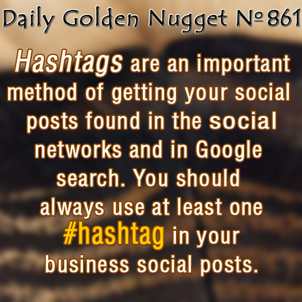 Hashtags are used in all the popular social networks, well, except LinkedIn. What's a hashtag? The simplest description is any word or phrase preceded by the symbol #.
Hashtags are used in all the popular social networks, well, except LinkedIn. What's a hashtag? The simplest description is any word or phrase preceded by the symbol #.What do you call the symbol #?
Depending on where you are in the world you will call that a "number sign," or a "pound sign," or simply a "hash."
According to Wikipedia there are many uses of the # symbol. If you live in the United States, when you see # before a number you're probably going to say or think "number," as in, today is Daily Golden Nugget #861. On the other hand if you see 861# you might say "861 pounds."
Use of the "hashtag" began in social media in August 2007 when Twitter wanted to develop a way to organize tweets on their network. It was quickly adopted and grew from there. (Side note, although it might seem like the recent IPO of Twitter inspired this Nugget, the truth is this nugget has been in the works for 2 months. Now that I'm finally publishing this, I have to say the timing is purely coincidental!)
Today hashtag functionality has been added to many social networks including Google+, Facebook, Instagram, Pinterest, and Tumblr to help organize social posts into similar groups.
Each social network has their own method of organizing their hashtags, but they all support the simple feature to click one of #those #words #with #the #hash #symbol to see all the other recent post by other people on the same topics.
You might have seen or heard of the phrase "trending topics" within different social networks and throughout search results. Many of those trending topics are easily identified when many people start using the same #hashtag in a short amount of time. As I write this, the #Christmas hashtag is gaining popularity.
Knowing what a hashtag is doesn't make you and expert in their usage. There are good and bad ways to use hashtags in the different social networks. Here are some basic methods of using them correctly.
The main rule of thumb is to remember that hashtags are used to organize social posts. For this reason you should always include appropriate hashtags at the end of your post, the exception to that is Twitter.
Since Twitter posts are limited to 140 characters, it's common to simply hash words within your sentences. This saves a few characters instead of repeating words at the end of the tweet. As an example, since the holiday shopping season has already started you could tweet:
They are already selling #Christmas #trees at Home Depot
That's 56 characters, which is better than the 71 characters used if you format that same tweet this way:
They are already selling Christmas Trees at Home Depot. #christmastrees
On the other hand you could use the hashtag to add extra information that you don't include in the tweet, and can give context where a sentence would otherwise not. Since today is Veterans' Day in the United States, you might want to tweet this message:
Thanking all those who have proudly served their country. #VeteransDay
When using hashtag on Google+, Facebook, Instagram, and everywhere else you should always include them at the end of the post. On Twitter you don't have enough characters to repeat words, but that's actually good practice everywhere else. You Google+ and Facebook posts should be well written with the hashtags included at the bottom.
Here's an example of a Facebook hashtag disaster:
https://www.facebook.com/photo.php?fbid=10151579096256146&set=a.270782901145.151183.190343851145&type=1
Here's the text:
#Last #Day of the Pandora FREE Bracelet Event!! #Birthday #Christmas #Gift #FREE #New #Silver #Bangle #LOVE"
Using hashtags will not make your post more popular. Again, they are a tool for sorting. When you riddle your posts with # symbols you are making regular reading difficult and worse, you are interrupting any real chance you have to get your marketing message across. Many posts that are hashtagged do not necessarily get seen by more people, simply because they have tags in common.
A better post of what's written above, may have been:
This is the last day of our Pandora FREE Bracelet Event!! Pandora charms are great gifts for birthdays, Christmas, and just because. Stop in today and you'll get a free silver bangle with your purchase of $100 or more. #Pandorabracelet #pandoracharm #christmasgift
What words should you hastag?
That's a difficult question to answer. If you hash the wrong word you might accidentally include your post in the wrong place. The best idea for beginners is to search Google+ and Twitter for words or phrases that relate to your business, services, and products. Keep track of the hashtags you find and click on all the ones that make sense. Carefully review how other people are using those potential hashtags before you start using them.
Hashtags are also widely used for satire, irony, and comedy. Using hashtags this way is good for customer interaction, brand building, and to show your personality. Here are some ideas:
They are already selling Christmas Trees at Home Depot. Thankfully they haven't started the Christmas music yet. #tooearly
Their marriage is over. #pawnthering
I have my Christmas gift list made up. I hope I didn't forget anyone. #checkingittwice
The idea of hashtags seems simple, but understanding how to use them will take a while. They are a great tool for getting yourself found, so make sure to use them from now on. Also, make sure if you're using them, you doublecheck the spelling; you might miss letters if connecting words have letters in common. You can capitalize words in the middle of hashs, such as #DoublecheckTheSpelling to get the point across.
We also don't want to consider how often something like #daimond might be trending, oblivious to its correctly spelled brethren.








